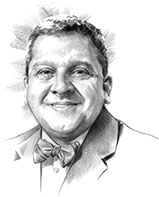From One Revolution to Another
Tell us what you think. E-mail comments or questions to the editors at letters@northwestern.edu.
Find Us on Social Media
Ali Shilatifard's journey — he navigated his way from post-revolution Iran as a teenager — and research endeavors led him to Northwestern, where he pursues promising pathways in the treatment of leukemia.
By Ali Shilatifard, Robert Francis Furchgott Professor and Chair of Biochemistry and Molecular Genetics and Professor of Pediatrics, Feinberg School of Medicine, Northwestern University
As a scientist dedicated to research related to the molecular understanding of childhood leukemia, I am gratified that my scientific journey has brought me to Northwestern. Along my path, I have not only discovered promising ways of treating leukemia, I have also been fortunate to shed significant light on other forms of cancer. My lifetime journey and pursuit of these questions has led me here, and I couldn’t have charted it better.

Illustration by Bruce Morser
I was born in Iran before the revolution, and my life was on course to be one of complexity and unexpected turns. My memories of childhood are heartwarming and filled with thoughts of a loving family, wonderful food and the freedom to explore Tehran with my buddies. I also worked many hours with my grandfather, a prominent physician-scientist, who exposed me to the beauty of medicine and the value of research.
Then came the Islamic Revolution: Iran was suddenly under the control of the Grand Ayatollah Ruhollah Khomeini. My life’s direction changed in a heartbeat.
When I was about 14 years old, Iran’s new government was at war with Iraq. Boys my age were being drafted to serve on the front lines, so my parents sent me to Turkey. I needed a job to support myself, and I soon found work as a telex operator at a metal manufacturing company, translating Farsi to whatever Turkish I had learned in a few months. Two years later I came to the United States on a student visa to learn English. After six months of study, I earned a GED diploma and applied for college.
During my four years at Kennesaw State University, I worked up to 70 hours a week to pay for tuition, at times sleeping in my car without money for rent or food. I also made irreplaceable friends. For graduate school, I joined Richard Cumming’s glycobiology lab at the University of Georgia and moved with him to the University of Oklahoma, where I received my PhD and completed my postdoctoral studies. It was there where I met the love of my life, my best friend, the mother of my four fantastic children — my wife, Laura — who has steadied my direction and enriched every step of my journey.
In my postdoctoral studies I identified the molecular and biochemical function of the ELL gene, which is associated with childhood leukemia. Then, while in my first faculty position at the St. Louis University School of Medicine, my lab discovered a group of proteins whose misregulation has a very strong link to cancer. These two discoveries directed my scientific journey, and I was then on a mission to identify and purify this complex that I named COMPASS (Complex of Proteins Associated with Saccharomyces cerevisiae Set1) and to see what mechanisms are causing cancer and how to prevent or treat them.
How serendipitous that this COMPASS guided me to the next stage of my direction. I was excited about my research, but I wanted to be a part of a larger purpose. The search for a chair of biochemistry and molecular genetics at Northwestern provided the opportunity I had been dreaming of — a great university and medical center where I could build a department with stellar colleagues and we could move science forward in a more revolutionary way.
When it comes to collaboration, Northwestern is a true pioneer. By bringing together Northwestern Medicine, Lurie Children’s Hospital and the Center for Molecular Innovation and Drug Discovery, we’ve been able to develop targeted therapeutics not only for the treatment of childhood leukemia but also for triple-negative breast cancer, as well as other cancer types. Further, with colleagues in Northwestern Medicine’s neurosurgery department and at Lurie Children’s, we have pinpointed the mechanism behind a particular type of pediatric brain tumor as well as a means of treating it. We hope to bring this treatment into the clinic soon.
Northwestern’s potential is unlike that of any place I’ve seen. I am honored to work in such a unique environment where great minds collaborate and support one another’s work. Having weathered one revolution, I now find myself here on the brink of a happier one — focused on the treatment of devastating human diseases.



 Facebook
Facebook Twitter
Twitter Email
Email


